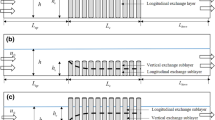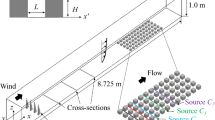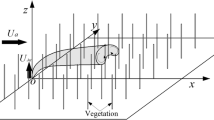Abstract
Predicting flow and mass transport in vegetated regions has a broad range of applications in ecology and engineering practice. This paper presents large eddy simulation (LES) of turbulent flow and scalar transport within a fully developed open-channel with submerged vegetation. To properly represent the scalar transport, an additional diffusivity was introduced within the canopy to account for the contribution of stem wakes, which were not resolved by the LES, to turbulent diffusion. The LES produced good agreement with the velocity and concentration fields measured in a flume experiment. The simulation revealed a secondary flow distributed symmetrically about the channel centerline, which differed significantly from the circulation in a bare channel. The secondary circulation accelerated the vertical spread of the plume both within and above the canopy layer. Quadrant analysis was used to identify the form and shape of canopy-scale turbulent structures within and above the vegetation canopy. Within the canopy, sweep events contributed more to momentum transfer than ejection events, whereas the opposite occurred above the canopy. The coherent structures were similar to those observed in terrestrial canopies, but smaller in scale due to the constraint of the water surface.



















Similar content being viewed by others
References
Wilcock R, Champion P, Nagels J, Crocker G (1999) The influence of aquatic macrophytes on the hydraulic and physico-chemical properties of a New Zealand lowland stream. Hydrobiologia 416:203–214
Schulz M, Kozerski H, Pluntke T, Rinke K (2003) The influence of macrophytes on sedimentation and nutrient retention in the lower River Spree (Germany). Water Res 37:569–578
Sand-Jensen K (1998) Influence of submerged macrophytes on sediment composition and near-bed flow in lowland streams. Freshwater Biol 39:663–679
Duarte CM, Losada IJ, Hendriks IE, Mazarrasa I, Marbà M (2013) The role of coastal plant communities for climate change mitigation and adaptation. Nat Clim Change 3:961–968
Peterson CH, Summerson HC, Duncan PB (1984) The influence of seagrass cover on population structure and individual growth rate of a suspension feeding bivalve, Mercenaria mercenaria. J Mar Res 42:123–138
Irlandi EA, Peterson CH (1991) Modification of animal habitat by large plants: mechanisms by which seagrasses influence clam growth. Oecologia 87:307–318
van Katwijk MM et al (2016) Global analysis of seagrass restoration: the importance of large-scale planting. J Appl Ecol 53:567–578
Hughes AR, Stachowicz JJ (2004) Genetic diversity enhances the resistance of a seagrass ecosystem to disturbance. Proc Natl Acad Sci 101:8998–9002
Ackerman JD (2002) Diffusivity in a marine macrophyte canopy: implications for submarine pollination and dispersal. Am J Bot 89:1119–1127
Murphy E, Ghisalberti M, Nepf HM (2007) Model and laboratory study of dispersion in flows with submerged vegetation. Water Resour Res 43:W05438
Lightbody AF, Nepf HM (2006) Prediction of near-field shear dispersion in an emergent canopy with heterogeneous morphology. Environ Fluid Mech 6:477–488
Poggi D, Porporato A, Ridolfi L, Albertson JD, Katul GG (2004) The effect of vegetation density on canopy sub-layer turbulence. Bound Layer Meteorol 111:565–587
Ghisalberti M, Nepf HM (2005) Mass transport in vegetated shear flows. Environ Fluid Mech 5:527–551
Ghisalberti M, Nepf HM (2004) The limited growth of vegetated shear layers. Water Resour Res 40:W07502
Raupach MR, Finnigan JJ, Brunet Y (1996) Coherent eddies and turbulence in vegetation canopies: the mixing-layer analogy. Bound Layer Meteorol 78:351–382
Nepf HM, Vivoni ER (2000) Flow structure in depth-limited, vegetated flow. J Geophys Res Oceans 105:28547–28557
López F, García M (2001) Mean flow and turbulence structure of open-channel flow through non-emergent vegetation. J Hydraul Eng 127:392–402
Tanino Y, Nepf HM (2008) Lateral dispersion in random cylinder arrays at high Reynolds number. J Fluid Mech 600:339–371
King AT, Tinoco RO, Cowen EA (2012) A \(k-\varepsilon\) turbulence model based on the scales of vertical shear and stem wakes valid for emergent and submerged vegetated flows. J Fluid Mech 701:1–39
Okamoto T, Nezu I (2010) Large eddy simulation of 3-D flow structure and mass transport in open-channel flows with submerged vegetations. J Hydr Res 4:185–197
Chant RJ (2010) Estuarine secondary circulation. In: Valle-Levinson A (ed) Contemporary issues in estuarine physics. Cambridge University Press, Cambridge, pp 100–124
Bradshaw P (1987) Turbulent secondary flows. Annu Rev Fluid Mech 19:53–74
Nepf HM, Sullivan JA, Zavistoski RA (1997) A model for diffusion within emergent vegetation. Limnol Oceanogr 42:1735–1745
Meneveau C, Lund TS, Cabot WH (1996) A Lagrangian dynamic subgrid-scale model of turbulence. J Fluid Mech 319:353–385
Cui J, Neary VS (2008) LES study of turbulent flows with submerged vegetation. J Hydraul Res 46:307–316
Yue W, Parlange MB, Meneveau C, Zhu W, Hout R, Katz J (2007) Large-eddy simulation of plant canopy flows using plant-scale representation. Bound Layer Meteorol 124:183–203
Vinçont JY, Simoëns S, Ayrault M, Wallace JM (2000) Passive scalar dispersion in a turbulent boundary layer from a line source at the wall and downstream of an obstacle. J Fluid Mech 424:127–167
Rossi R, Iaccarino G (2009) Numerical simulation of scalar dispersion downstream of a square obstacle using gradient-transport type models. Atmos Environ 43:2518–2531
Jansen KM, Kong B, Fox RO, Hill JC, Olsen MG (2015) Large eddy simulation of passive scalar transport in a high Schmidt number turbulent incompressible wake with experimental validation. Chem Eng Sci 137:862–874
Yan C, Huang WX, Cui GX, Xu C, Zhang ZS (2015) A ghost-cell immersed boundary method for large-eddy simulation of flows in complex geometries. Int J Comput Fluid Dyn 29:12–25
Ghisalberti M, Nepf HM (2006) The structure of the shear layer in flows over rigid and flexible canopies. Environ Fluid Mech 6:277–301
Belcher SE, Jerram N, Hunt JCR (2003) Adjustment of a turbulent boundary layer to a canopy of roughness elements. J Fluid Mech 488:369–398
Bou-Zeid E, Parlange MB, Meneveau C (2007) On the parameterization of surface roughness at regional scales. J Atmos Sci 64:216–227
Cassan L, Belaud G, Baume JP, Dejean C, Moulin F (2015) Velocity profiles in a real vegetated channel. Environ Fluid Mech 15:1263–1279
Nezu I, Nakagawa H (1989) Self-forming mechanism of longitudinal sand ridges and troughs. In: Proceedings of 23rd IAHR congress, vol B, IAHR, Delft, The Netherlands, pp 65–72
Finnigan JJ (2000) Turbulence in plant canopies. Annu Rev Fluid Mech 32:519–571
Wallace JM (2016) Quadrant analysis in turbulence research: history and evolution. Annu Rev Fluid Mech 48:131–158
Nepf HM, Ghisalberti M, White B, Murphy E (2007) Retention time and dispersion associated with submerged aquatic canopies. Water Resour Res 43:W04422
Volino RJ, Schultz MP, Flack KA (2007) Turbulence structure in rough- and smooth-wall boundary layers. J Fluid Mech 592:263–293
Perkins HJ (1970) The formation of streamwise vorticity in turbulent flow. J Fluid Mech 44:721–740
Huser A, Biringen S (1993) Direct numerical simulation of turbulent flow in a square duct. J Fluid Mech 257:65–95
Gavrilakis S (1992) Numerical simulation of low-Reynolds-number turbulent flow through a straight square duct. J Fluid Mech 244:101–129
Ghisalberti M (2010) The three-dimensionality of obstructed shear flows. Environ Fluid Mech 10:329–343
Nezu I, Nakagawa H, Tominaga A (1985) Secondary currents in a straight channel flow and the relation to its aspect ratio. In: Bradbury LJS et al (eds) Turbulent shear flows 4. Springer, New York, pp 246–260
Culbertson JK (1967) Evidence of secondary circulation in an alluvial channel. Geological survey research, US seol survey, pp D214–D215
Acknowledgements
The work was supported by National Natural Science Foundation of China under Grants No. 11132005 and 11322221, and by US National Science Foundation Grant No. AGS-1005480. The authors would also like to thank Tsinghua National Laboratory for Information Science and Technology for the support in parallel computing.
Author information
Authors and Affiliations
Corresponding author
Rights and permissions
About this article
Cite this article
Yan, C., Nepf, H.M., Huang, WX. et al. Large eddy simulation of flow and scalar transport in a vegetated channel. Environ Fluid Mech 17, 497–519 (2017). https://doi.org/10.1007/s10652-016-9503-y
Received:
Accepted:
Published:
Issue Date:
DOI: https://doi.org/10.1007/s10652-016-9503-y




